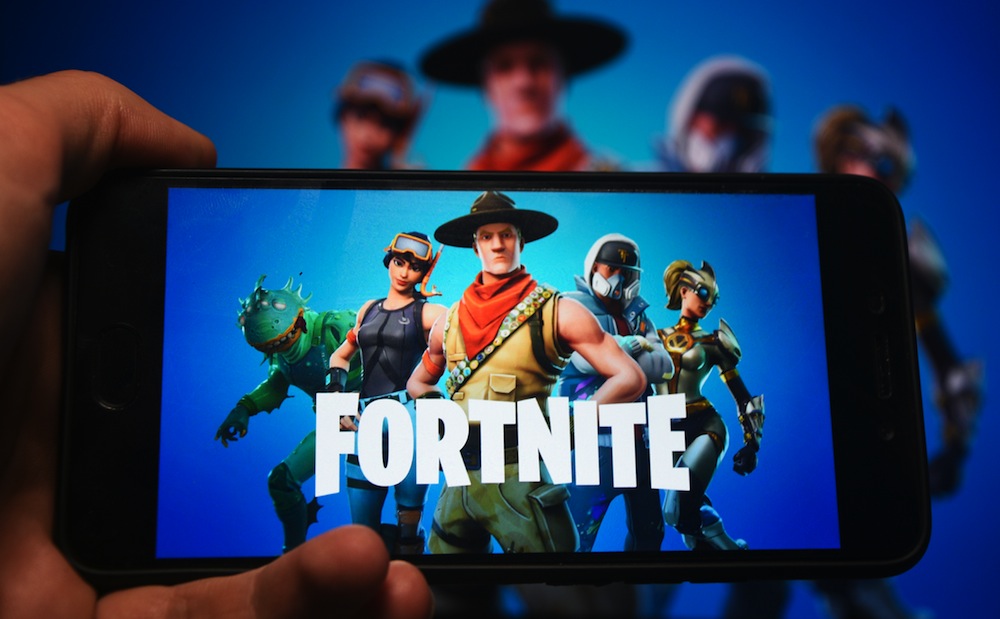
Mariupol, Ukraine; Dec 21, 2018: Hand holding phone with Fortnite logo displayed in it with fluctuating graphic on background.
I work in the game business. The company I work for, Global Worldwide (GlobalWorldwide.com) is in the process of finishing a mobile game named Kingdom Maker (KingdomMaker.com), which I sometimes describe as Game of Thrones meets Farmville. It’s a bit of a full circle for me, since I was one of the original creators of the Chessmaster series of computer-based chess games in 1986.
Video games—whether on personal computers, consoles like the Xbox or PlayStation, or smartphones—are a big business. Worldwide revenues for games were about $150 billion in 2019, generating more revenue than the film industry ($101 billion in 2019) and the music industry ($20.2 billion in 2019) combined. And the mobile game business represents more than a third of the game business overall ($68 billion).
Like movies and films, games are a hit-driven business. A single game, Fortnite, made $1.8 billion dollars in 2019. (It was the top-selling game of the year). There’s an interesting twist here though. When you go see a movie (or rent one for streaming as we’ve been doing for the past year of the pandemic), you pay up front. Likewise when you buy a CD or a track on iTunes. But games have introduced the concept of “free-to- play,” where you can play a hit game without paying anything at all.
Some free-to-play games are supported by advertisers, and the ads are displayed as part of the game layout, or during breaks in game play. But the basis for the most successful free-to-play games, of which Fortnite is a shining example, is what is known as “in-game purchases.” You can play the game for free, but can also spend real money to enhance your game experience. In-game purchases are typically made with an in-game currency. Fortnite players buy things with “V-bucks.” In Kingdom Maker, purchases are made with “gold.”
In both cases, the in-game currency is purchased with real money via a credit card transaction. Part of the rationale behind in-game currency is that microtransactions (spending a few cents at a time) aren’t really compatible with the per-transaction expense of credit cards. It also allows the game to encourage buying more in-game currency with discounts. For example, 1,000 V-Bucks cost $9.99. But you can buy 13,500 V-bucks for the price of 10,000 V-Bucks (a $99.99 purchase, but more than a third more currency). Finally, virtual currency reduces the player’s sense of how much they are spending. Quick: how much are you spending when you spend 37 VBucks? See how that works?
As you might expect, most players don’t spend money. For a successful game, the vast majority of revenue comes from a minuscule number of players. I know of at least one online game where 75 percent of the revenue came from 0.2 percent of the people. As in the casino business, big in-game spenders are referred to as “whales.” There are even “fast” whales and “slow” whales, categorized by how quickly they spend money.
The real key idea behind a successful free-to-play game is to understand what players—especially whales—want and provide an opportunity to spend money to make that happen. For example, reducing the time it takes to heal an injured character, so they can get back in the name more quickly. In this case, if you don’t spend money, your injured character eventually heals, but it takes longer. This works because of the psychology of game play. Waiting for that injured character to heal delays the pleasure the player experiences when actively playing the game.
It costs some amount of money for a game to acquire a new player: the cost of acquisition. For a game to be viable, players must generate more revenue over their “lifetime” with the game that it costs to acquire them. It sounds obvious, but it’s actually a combination of art (designing a game that holds a player’s interest while encouraging them to spend money) and science (monitoring each step of the game to see what works and what doesn’t).
There are numerous key performance indicators to monitor. One of the most important is the Average Revenue Per Daily Active User (ARPDAU, pronounced arp-dow). It’s exactly what it says: the amount of money a game makes in a day, divided by the number of people who played the game that day. For most free-to-play games, ARPDAU is less than a penny. Very successful games might make a quarter.
Due to the cost of acquisition, a lot of attention is paid to the number of players retained over a period of time. For the players acquired on a given day, how many are still playing the game after a day, a week, and a month? Failing to retain a user you paid to acquire long enough for them to spend money is a serious problem.
I’ll be writing more about this next month. Until then, please send your tech questions to me at mike@mikeduffy.com.
Author
-

Michael E. Duffy is a 70-year-old senior software engineer for Electronic Arts. He lives in Sonoma County and has been writing about technology and business for NorthBay biz since 2001.
View all posts



